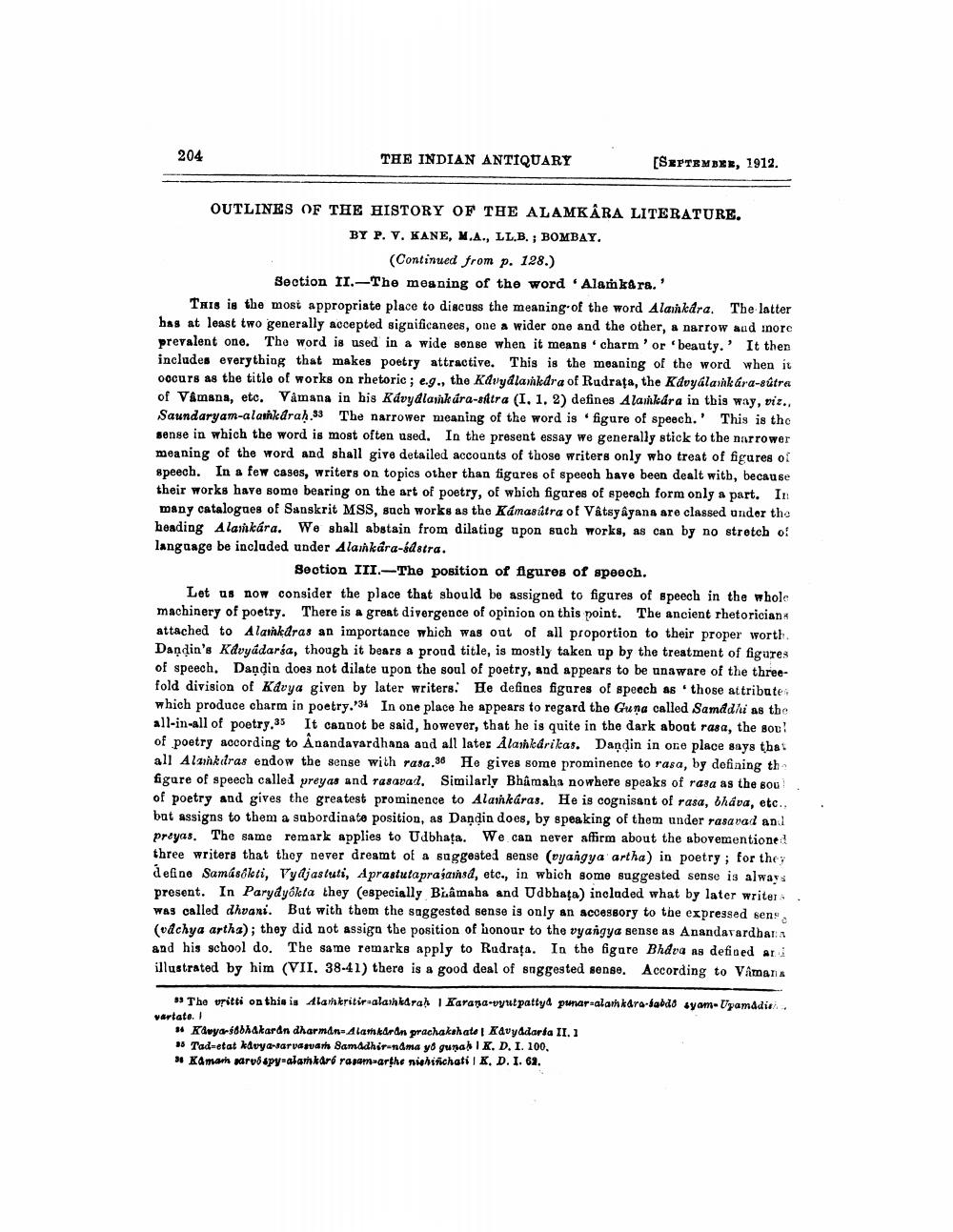________________
204
THE INDIAN ANTIQUARY
[SEPTEMBER, 1912.
OUTLINES OF THE HISTORY OF THE ALAMKARA LITERATURE.
BY P. V. KANE, M.A., LL.B.; BOMBAY.
(Continued from p. 128.)
Section II.-The meaning of the word Alamkara.'
THIS is the most appropriate place to discuss the meaning of the word Alamkára. The latter has at least two generally accepted significanees, one a wider one and the other, a narrow and more prevalent one. The word is used in a wide sense when it means charm' or 'beauty.' It then includes everything that makes poetry attractive. This is the meaning of the word when it occurs as the title of works on rhetoric; e.g., the Kavyalamkdra of Rudrata, the Kavyalamkára-sûtra of Vamana, etc. Vamana in his Kávy dlankára-stra (I. 1. 2) defines Alamkára in this way, viz., Saundaryam-alamkaraḥ.33 The narrower meaning of the word is figure of speech. This is the sense in which the word is most often used. In the present essay we generally stick to the narrower meaning of the word and shall give detailed accounts of those writers only who treat of figures of speech. In a few cases, writers on topics other than figures of speech have been dealt with, because their works have some bearing on the art of poetry, of which figures of speech form only a part. In many catalogues of Sanskrit MSS, such works as the Kámasútra of Vâtsyâyana are classed under the heading Alamkára. We shall abstain from dilating upon such works, as can by no stretch of language be included under Alankara-sastra.
Section III. The position of figures of speech.
"
Let us now consider the place that should be assigned to figures of speech in the whole machinery of poetry. There is a great divergence of opinion on this point. The ancient rhetorician attached to Alamkaras an importance which was out of all proportion to their proper worth. Dandin's Kavyadarsa, though it bears a proud title, is mostly taken up by the treatment of figures of speech. Dandin does not dilate upon the soul of poetry, and appears to be unaware of the threefold division of Kavya given by later writers. He defines figures of speech as those attributes which produce charm in poetry.'3 In one place he appears to regard the Guna called Samadhi as the all-in-all of poetry,35 It cannot be said, however, that he is quite in the dark about rasa, the sou! of poetry according to Anandavardhana and all later Alamkarikas. Dandin in one place says that all Alankdras endow the sense with rasa.36 He gives some prominence to rasa, by defining the figure of speech called preyas and rasavad. Similarly Bhâmaha nowhere speaks of rasa as the sou of poetry and gives the greatest prominence to Alankaras. He is cognisant of rasa, bhava, etc... bat assigns to them a subordinate position, as Danḍin does, by speaking of them under rasavad and preyas. The same remark applies to Udbhata. We can never affirm about the abovementioned three writers that they never dreamt of a suggested sense (vyangya artha) in poetry; for they define Samásokti, Vyajastuti, Aprastutaprasamsa, etc., in which some suggested sense is always present. In Parydyôkta they (especially Biâmaha and Udbhața) included what by later writer was called dhvani. But with them the suggested sense is only an accessory to the expressed sens (vachya artha); they did not assign the position of honour to the vyangya sense as Anandavardhana and his school do. The same remarks apply to Rudrata. In the figure Bhava as defined and illustrated by him (VII. 38-41) there is a good deal of suggested sense. According to Vâmana
33 The vritti on this is Alankritir-alaikarah | Karana-vyutpattyd punar-alamkara-sabdo syam-Upamadish. vartate. I
34 Kavya-s6bhakaran dharman-Alamkaran prachakshate | Kavyddarta II. 1
35 Tad-etat kavya-sarvasvam Samadhir-nama yo gunah | K. D. I. 100,
38 Kamam sarvo spy-alamkaró rasam-arthe nishiñchati | K. D. I. 69.




